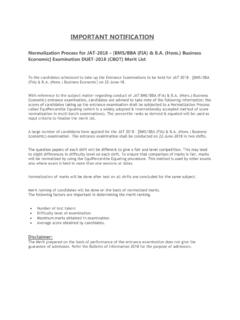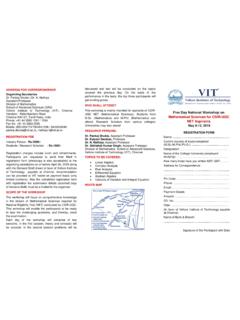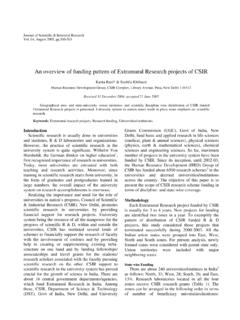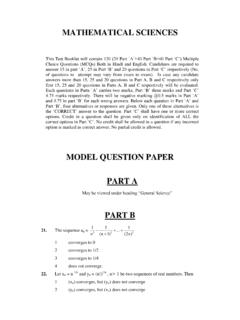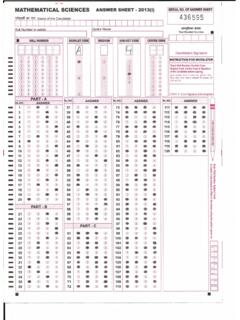Transcription of Proposed Syllabus for B.Sc. Program Mathematical …
1 1 Proposed Syllabus for Program Mathematical Science Submitted to Faculty of Mathematical sciences University of Delhi,Delhi-110007. Under Choice Based Credit System May 2015 2 CHOICE BASED CREDIT SYSTEM Program Mathematical Science 3 Course Structure Details of courses under Program Mathematical Science Course *Credits Theory+ Practical Theory + Tutorial ======================================== ======================= I. Core Course (12 Papers) 12X4= 48 12X5=60 04 Courses from each of the 03 disciplines of choice Core Course Practical / Tutorial* (12 Practical/ Tutorials*) 12X2=24 12X1=12 04 Courses from each of the 03 disciplines of choice II.
2 Elective Course (6 Papers) 6X4=24 6X5=30 Two papers from each discipline of choice including paper of interdisciplinary nature Elective Course Practical / Tutorials* 6 X 2=12 6X1=6 (6 Practicals / Tutorials*) Two papers from each discipline of choice including paper of interdisciplinary nature Optional Dissertation or project work in place of one Discipline Specific Elective paper (6 credits) in 6th Semester III. Ability Enhancement Courses 1. Ability Enhancement Compulsory Courses (AECC) (2 Papers of 2 credit each) 2 X 2=4 2 X 2=4 Environmental Science English/MIL Communication 2. Skill Enhancement Courses (SEC) (Minimum 2) 4 X 2=8 4 X 2=8 (4 Papers of 2 credit each) Total credit 120 120 Institute should evolve a system/policy about ECA/ General Interest/Hobby/Sports/NCC/NSS/related courses on its own.
3 * wherever there is a practical there will be no tutorial and vice-versa 4 Proposed SCHEME FOR CHOICE BASED CREDIT SYSTEM IN B. Sc. Program with Computer Science SEMESTER CORE COURSE (12) Ability Enhancement Compulsory Course (AECC) (2) Skill Enhancement Course (SEC) (4) Elective: Discipline Specific DSE (6) I Problem Solving using Computer II Database Management Systems III Operating Systems SEC 1 IV Computer System Architecture SEC 2 V SEC 3 DSE 1A DSE 2A DSE 3A VI SEC 4 DSE 1B DSE 2B DSE 3B 5 SEMES TER COURSE OPTED COURSE NAME Credits I Ability Enhancement Compulsory Course-I English/MIL communications/ Environmental Science 2 Core course-I Problem Solving using Computer 4 Core Course-I Practical/Tutorial Software Lab using Python 2 Core course-II DSC 2A 6 Core Course-III DSC 3A 6 II Ability Enhancement Compulsory Course-II English/MIL communications/ Environmental Science 2 Core course-IV Database Management Systems
4 4 Core Course-IV Practical/Tutorial Database Management Systems Lab 2 Core course-V DSC 2B 6 Core Course-VI DSC 3B 6 III Core course-VII Operating Systems 4 Core Course-VII Practical/Tutorial Operating Systems Lab 2 Core course-VIII DSC 2C 6 Core Course-IX DSC 3C 6 Skill Enhancement Course -1 SEC-1 2 IV Core course-X Computer System Architecture 4 Course-X Practical/Tutorial Computer System Architecture Lab 2 Core course-XI DSC 2D 6 Course-XII DSC 3D 6 Skill Enhancement Course -2 SEC -2 2 V Skill Enhancement Course -3 SEC -3 2 Discipline Specific Elective -1 DSE-1A 6 Discipline Specific Elective -2 DSE-2A 6 Discipline Specific Elective -3 DSE-3A 6 VI Skill Enhancement Course -4 SEC -4 2 Discipline Specific Elective -4 DSE-1B 6 Discipline Specific Elective -5 DSE-2B 6 Discipline Specific Elective -6 DSE-3B 6 Total Credits 120 6 Core Papers: Computer Science (Credit: 06 each) (1 period / week for tutorials or 4 periods / week of practical) 1.
5 Problem Solving using Computer 2. Database Management Systems 3. Operating System 4. Computer System Architecture Discipline Specific Elective Papers: (Credit: 06 each) (DSE-1, DSE -2) Choose 2: One from each group. Options for DSE-1: 1. Programming in JAVA 2. Analysis of Algorithms and Data Structures Options for DSE-2: 1. Internet Technologies 2. Project Work / Dissertation Note: Universities may include more options or delete some from this list Skill Enhancement Courses (any four) (Credit: 02 each) SEC1, SEC2, SEC3, SEC4 Choose one from each group. Options for SEC1: 1. Office Automation Tools Options for SEC2: 1. PHP Programming Options for SEC3: 1.
6 System Administration and Maintenance Options for SEC4: 1. Android Programming Note: Universities may include more options or delete some from this list Important: 7 1. Each University/Institute should provide a brief write-up about each paper outlining the salient features, utility, learning objectives and prerequisites. 2. University/Institute can add/delete some experiments of similar nature in the Laboratory papers. 3. The size of the practical group for practical papers is recommended to be 10-15 students. 4. University/Institute can add to the list of reference books given at the end of each paper. CORE PAPERS: 1. Problem Solving using Computer Total Marks:150 Theory 75 Practical: 50 Internal Assessment: 25 5 Lectures ,4 Practicals ( each in group of 10 to 15) Computer Fundamentals: Introduction to Computers: Characteristics of Computers, Uses of computers, Types and generations of Computers.
7 (2L) Basic Computer Organization - Units of a computer, CPU, ALU, memory hierarchy, registers, I/O devices. (2L) Programming with Python Planning the Computer Program : Concept of problem solving, Problem definition, Program design, Debugging, Types of errors in programming, Documentation. Techniques of Problem Solving: Flowcharting, decision table, algorithms, Structured programming concepts, Programming methodologies viz. top-down and bottom-up programming. Overview of Programming : Structure of a Python Program , Elements of Python Introduction to Python: Python Interpreter, Using Python as calculator, Python shell, Indentation.
8 Atoms, Identifiers and keywords, Literals, Strings, Operators(Arithmetic operator, Relational operator, Logical or Boolean operator, Assignment, Operator, Ternary operator, Bit wise operator, Increment or Decrement 4L 6L 4L 4L 8 operator) Creating Python programs :Input and Output Statements, Control statements(Branching, Looping, Conditional Statement, Exit function, Difference between break, continue and pass.), Defining Functions, default arguments, Errors and Exceptions. Iteration and Recursion: Conditional execution, Alternative execution, Nested conditionals, The return statement, Recursion, Stack diagrams for recursive functions, Multiple assignment, The while statement, Tables, Two-dimensional tables Strings and Lists: String as a compound data type, Length, Traversal and the for loop, String slices, String comparison, A find function, Looping and counting, List values, Accessing elements, List length, List membership, Lists and for loops, List operations, List deletion.
9 Cloning lists, Nested lists Object Oriented Programming: Introduction to Classes, Objects and Methods, Standard Libraries. Data Structures: Arrays, list, set, stacks and queues. Searching and Sorting: Linear and Binary Search, Bubble, Selection and Insertion sorting. 8L 8L 8L 4L 4L 6L Books and Study Material Recommended: 1. P. K. Sinha & Priti Sinha , Computer Fundamentals , BPB Publications, 2007. 2. Dr. Anita Goel, Computer Fundamentals, Pearson Education, 2010. 3. T. Budd, Exploring Python, TMH, 1st Ed, 2011 4. Python Tutorial/Documentation 5. Allen Downey, Jeffrey Elkner, Chris to think like a computer scientist learning with Python / 1st Edition,2012 Freely available online.
10 6. 7. 8. Software Lab using Python: Section: A ( Simple programs ) 1. Write a menu driven Program to convert the given temperature from Fahrenheit to Celsius and vice versa depending upon user s choice. 2. WAP to calculate total marks, percentage and grade of a student. Marks obtained in each of the three subjects are to be input by the user. Assign grades according to the following criteria : Grade A: Percentage >=80 Grade B: Percentage>=70 and <80 Grade C: Percentage>=60 and <70 Grade D: Percentage>=40 and <60 9 Grade E: Percentage<40 3. Write a menu-driven Program , using user-defined functions to find the area of rectangle, square, circle and triangle by accepting suitable input parameters from user.




